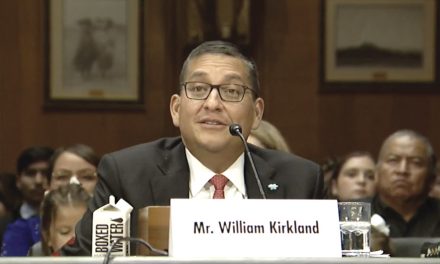
50 Years Ago: Hopi Tribe impounds Diné livestock, set up hold fees
The tension between Navajos and Hopis over Navajo cattle wandering onto the Hopi Reservation has increased substantially in the past few weeks.
Fed up with the failure of Navajo ranchers to control their livestock and keep them off Hopi land, the Hopi Tribe has been impounding any Navajo livestock found on Hopi Reservation land. According to reports, this has amounted to more than 400 sheep since late October.
Navajo officials have filed a complaint to the BIA pointing out that since there are no fences between Hopi and Navajo lands, the ranchers have little control over where the sheep roam. And since the land in the Navajo Reservation is severely overgrazed, it’s not surprising that the Navajo sheep are going to greener pastures.
The Hopis have set up procedures that allow Navajo ranchers to pay an impound fee to get their livestock back and while a few ranchers have taken that route to get their sheep back, others have not, which led this week to the Hopi Tribe holding an auction and selling animal impounded animals show owners have not paid an impoundment fee.
Navajo Tribal Chairman Peter MacDonald said once his office was informed of the auction, they planned to go to it and submit bids to get the sheep so they could be returned to their owners. Unfortunately, the auction had already been held and the sheep were gone.
When Navajo land officials investigated the matter, they found that the main reason why no one paid the impoundment fee was because there was no brands or the livestock owner did not realize his sheep had been impounded until after the auction was held.
George Vlassis, who was general counsel to MacDonald, said the Navajos have no right to stop the Hopis from holding auctions. He also advised MacDonald that the BIA was also powerless to stop the auctions.
He recommended that the Navajos build a fence around the Hopi Reservation to make sure the Navajo sheep stay on their side but tribal Council members balked at the expense, arguing that if a fence needed to be built the Hopis should do it.
MacDonald said he has met with his counterpart in the Hopi government, Clarence Hamilton, and has urged him to work with him to come to a solution to the problem before it leads to violence. Once that happens, the BIA would be forced to intervene and it would be better if the two tribes could resolve the problem themselves without having an outside agency do it.
Council Delegate Annie Wauneka said she was in favor of the Navajos building their own fence. But she was concerned that the fences would be cut by Hopis who wanted the conflict to escalate to force Congress to pass legislation that would resolve the land dispute once and for all.
Hamilton said he also thought this would be a problem if a fence was erected. He suggested that the Navajos set up a fund to pay the impoundment fees to prevent another auction and MacDonald said the Council took this under consideration.
Leon Cook makes Times’ front-page
Chet MacRorie, the managing editor of the Navajo Times, has filled one of the new positions created in this year’s budget by hiring Paul Natonabah as a photographer and writer.
On Thanksgiving 1971, he had his first front-page article: the election of Leon F. Cook, a Red Lake Chippewa, as the new head of the National Congress of American Indians.
Over the next 45 years, Natonabah would become the face of the Times to many members of the tribe as he would travel thousands of miles annually to cover high school football and basketball games as well as rodeos. He also was on hand for most of the historic events that occurred during that time.
By 1987, a collection of photos that he took provided a valuable portrait of the tribe during the 1970s and 1980s.
Tragically, his whole collection of photos during those years disappeared when MacDonald shut down the paper in1987 for several months after being elected for his fourth term.
He would later say that he closed the paper down because it was losing too much money trying to put out a daily edition. Others said he had retaliated against the paper because it had endorsed MacDonald’s opponent in the election, Peterson Zah. When it reopened, it went back to a weekly paper.
Diné leaders discuss trash problem
The Navajo Tribe, maybe for the first time ever, is talking about addressing one of the problems that have been plaguing the reservation for decades –piles of trash that are now seen throughout the reservation.
Except for the big communities, there is no organized trash pickup, which means most reservation residents are tasked with the responsibility of figuring out how to depose of the trash.
Many take their trash with them when they make their weekly trips to a border community to shop, leaving it in the first trash container they find that is empty. But many just go to the outskirts of their community, find a place where others have been using it for years and dump their trash there.
There is talk inside the tribal government about appropriating a lot of money – $100,000 or more – to hire someone to go to these sites and clean them up. Some of these sites existed for several decades and by now include tons of waste and possibly old appliances that are no longer useful.
Another idea is to turn this problem over to the chapters to resolve since the feeling is that stern messages from chapters may carry more weight than a plea from the tribal government to stop illegal dumping.
Howard Gorman, the delegate from Ganado, told the Times that this was a problem that would continue to plague the tribal government until transfer stations are established throughout the reservation where people can take trash.
Not much came from these talks. The tribe would come out with an advertising campaign urging tribal members to “walk in beauty” and be responsible, but it would be almost eight years before a program would actually be put in place to clean up some of the worst dump sites.








 Highway 264,
Highway 264, I-40, WB @ Winslow
I-40, WB @ Winslow